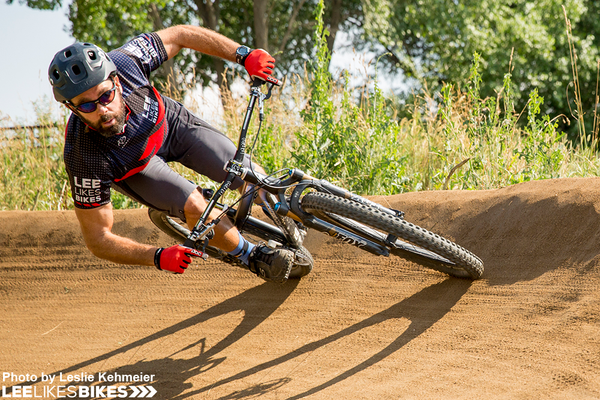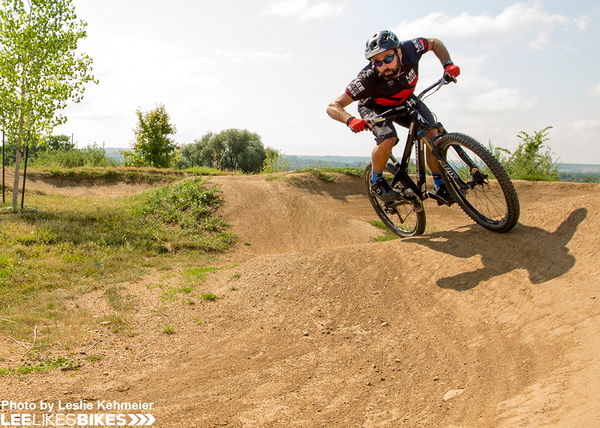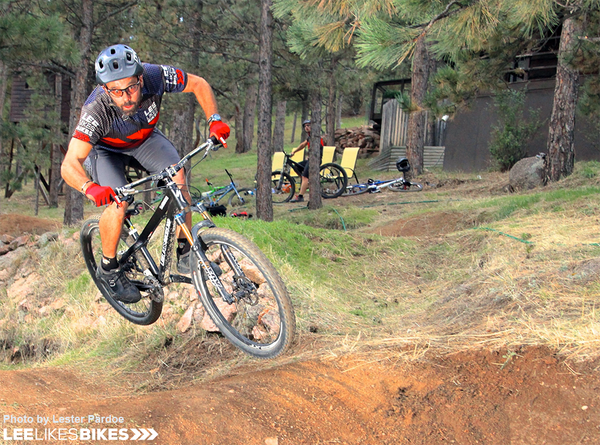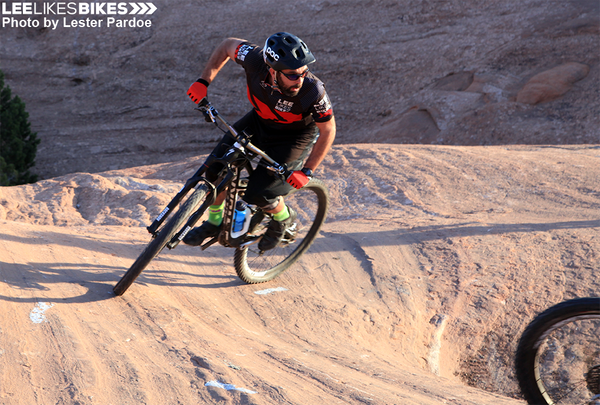Lee McCormack interview
Happy to bring to you an interview with Lee McCormack, a mtb "Kung Fu" master, coach and author of the Mastering Mountain Bike Skills. Sit (because is a long interview) and learn!!!
General info about Lee Mccormack
Instagram: @Leelikesbikes
Youtube: @lee_likes_bikes

AllMountainStyle.com: Hello Lee, for the readers that don't know who you are or that don't know your background. Tell us a little bit about you and your "Biking Life"
Lee McCormack: My name is Lee McCormack, and I like bikes. That's why my website is www.leelikesbikes.com. I'm a husband and dad in Boulder, CO.
I've been a stoked rider and communicator for more than 25 years. Growing up, I was a fat kid in a Weight Watchers family. I was told, over and over, that I was genetically a bad athlete, and that I should focus on other things. Well … At age 19 I saw mountain bikes and said, “Wow, with 18 gears I’ll bet I can ride up anything!” We all know how tough riding is when you’re in terrible shape, but it was fun, and it just made me feel good. And proud.
Within a couple years, I knocked my ride to school down from 47 minutes to 19 minutes, and my body started to change. As the fat melted off and muscles began to show, something even more powerful happened: Some powerful, hidden part of my soul came out. I had more confidence. More swagger. More stoke. And so I became a mountain biker.
At the same time, I began honing my professional skills. First in newspapers, then in software and the Web.
As I enjoyed success on the bike and at work, I felt an ever-growing sense of unease. Like I was meant for something different, something special: something that would combine my riding and communication skills. Finally, about 10 years ago, I was in the Palo Alto Theater with a bunch of Silicon Valley millionaires, watching the movie Whale Rider. This movie is all about fate. In it, a Maori girl is destined to become the king of her tribe -- which is not an easy thing! As the story unfolded, I started to cry. Was I honoring my fate? No, not yet. By the end of the movie, I was bawling uncontrollably, and that was it. I went to work and quit.
Going from six figures to zero figures overnight is pretty stressful. As fate would have it, my old riding buddy Brian Lopes alled to say hi. I said I wanted to write the definitive how-to book, and Brian said, Sure, I’ll do that with you. And the first Mastering Mountain Bike Skills was born.
After MMBS came out, I decided mountain biking deserves a curriculum like skiing and other “real” sports. Using all of my riding, communication and design skills, I began to design a teaching method. And I began to teach it.
I love to ride, but my true passion -- and purpose -- is helping other people ride. Teaching is the fullest expression of my physical, mental and emotional abilities. It’s what I'm made to do.
AMS: Your books and clinics are the Holy Bible of any mountain biker that wants to improve. Which is, based on your experience, the most common mistake or bad habit of the bikers attending your clinics?
LM: The most common -- and detrimental -- mistake all riders make is thinking they're experts and can't learn any more. That's the end of your development as a rider and, eventually, the end of your fun in the sport. Imagine a chart where challenge is vertical and fun is horizontal. Fun happens where challenge and skill intersect. If you don't develop your skills over time, you fall out of the sweet spot.
I get the occasional husband or boyfriend who thinks he knows everything and is just there for his wife or girlfriend. These guys usually start the clinic annoyed, like they're too cool for school. Then their women start to out-ride them, and they get frustrated. The smart guys see what's going on and start learning too. Then they're stoked!
But most people come to learn, so that's a different question.
The most common mistake or bad habit? Most riders have terrible balance on the bike (and off the bike too). When they're confident, they're too far forward, which is dangerous. When they're nervous, they're too far back -- which is even more dangerous. The big crashes -- the ones that really hurt people -- happen from being catapulted forward over the bars. Believe it or not, that comes from being too far back on the bike.

AMS: We love the “Brake Less, Pump More” sentence and we have it printed on our jersey. If you had to pick only one, which is the change, technique, drill or habit that produces the bigger step ahead in terms of confidence, speed, and above all … joy of riding?
LM: In the beginning it would be "Heavy Feet, Light Hands." This puts you in the middle of the bike, where you're safe and you can make the bike do great things.
As your core skills get dialed in, your focus should be more on terrain. At this point I like "Sine Wave of Love." Perceive the natural wave shape of the trail, then get in phase with it!
AMS: Why would you recommend our readers to attend a riding clinic, and which advice would you give them to help identify a good coach and/or school?
LM: Like I said before, fun happens at the intersection of challenge and skill. If you want to have fun over the long term (not to mention get faster, go bigger, win races, etc.), you need to hone your skills.
If you're a beginner, you can avoid lots of fear, injury and bad habits.
If you're an expert, you can ride faster, bigger, radder -- while staying smoother and safer.
If you're a professional, this is the smartest investment you can make. A few top U.S. enduro racers came from XC racing with exhausted careers and incomplete skills, and I helped them start over again. I've seen elite XC racers gain 8% sustained power purely with skill. I've seen riders improve their sprint power over 50% in less than an hour, purely with skill. I've helped DH racers stay safe and win races. The list goes on and on.
So, yeah, get yourself some help!
As far as picking a coach or school, I'll say this:
- Keep in mind that teaching skills and executing skills are completely different operations. An old pro license and a pulse does not make an instructor. The standard out there is very low.
- Make sure they have a system, and that is makes sense. Don't settle for the "Do it like this Bro" approach. If you ask a simple question, you should expect a simple answer. Too much "Bro" and too many big words are signs that the person doesn't know what he or she is talking about.
- Your teacher doesn't have to be the fastest pro on Earth, but he or she must ride cleanly -- and consistently demonstrate perfect form. Every moment you watch someone ride, you're learning at a subconscious level. Make sure you're programming yourself with quality data.
- You have to respect and like the person, and he or she has to be able to connect with you. Every rider is different, and a good teacher knows how to reach everyone. All of the coaches who work for Lee Likes Bikes are real people with real lives, real careers and a real passion for riding. This helps them relate to real people.
We at LLB teach all over the United States, and we can travel pretty much anywhere. No matter where you live, you can take advantage of my remote coaching program

AMS: You've been riding and coaching with some pro-riders. Who impressed you the most?
LM: One of my favorite people to ride with is U.S. enduro star Curtis Keene. We've been friends for years, and we used to ride and travel together all the time. Curtis has a playful, dolphin-like approach to terrain (If you want to see Sine Waves of Love, watch his videos, of which there are many). He's good at showing me 5% more than I think I can do, then pulling me right along. Some of my funnest moments on a bike have been on his wheel. Plus he's a nice guy who knows every good burrito shop on this planet.
One of my favorite students is 7X XTERRA world champion Conrad "The Caveman" Stoltz. He's been the best rider in the sport for a long time, and at the age of 41 he's still winning big races. Conrad is a gifted human: a freak of nature. But what makes him great over the decades is his beginner's mindset. Despite all his success, he's still a student, and he's learning all the time. Wait, maybe that's why he's so successful. Recently Conrad and I were out shooting a video.
I train hard and smart, but I'm just an average guy. At the top of a climb my heart rate was about 155: not hurting but definitely working. I looked at Conrad's heart rate monitor, and his heart rate was … 78!
Another pro racer I'm impressed with is Macky Franklin. He's a real talent with a learner's mindset, and he's doing well on the elite enduro circuit. Watch out for him!
AMS: If you could only have one bike. Which one would you choose?
LM: Yikes! One bike? Say that will never happen! Modern trail bikes are super fun and versatile.
If I could only have one bike for every kind of riding I do -- pump track, slalom, dirt jumps, slopestyle, trail, downhill, road and all of my coaching -- I'd pick a short- to mid-travel trail bike, probably with 29-inch wheels. My Specialized Camber is already a great all-around machine. If I had to give up my P3, SX, Stumpjumper hardtail, Enduro and Demo, I'd dial in the Camber with a bit more fork and burlier wheels. Or go back to riding a Stumpjumper 29 all the time (I did this for a couple seasons).

AMS: 26", 27.5", 29" … now talking about 27.5"PLUS. Are we nuts? What do you recommend our readers? Forget about wheel size and get out and enjoy with what you have under your butt?
LM: In the old days you ran a 26x2ish tire, and that was it. No other options and nothing to worry about. And we were happy. These days the options for wheel diameter and tire size are indeed getting crazy. The choices are really hard for consumers, and even harder for bike shops.
Cars have all sorts of wheels and tires. Do people go looking for a 15er or a 16er, or if, you're a rapper, a 22er? No. They choose the style of car that meets their needs, and it comes with the wheels it comes with. Some drivers customize their wheels, but smart engineers and designers decide which wheels make the most sense for each car, and there are few smart reasons to change.
What kind of riding do you want to do? How do you want your bike to feel? How big is your body? How much money can you spend? What color do you like? Which local shop do you want to build a relationship with? Pick a bike that meets those needs. It'll have whichever wheels make the most sense.
I personally like 29-inch wheels on my trail bikes. A) My limiting factor is aerobic capacity, and bigger wheels help me carry a bit more speed when I'm out with stronger riders. B) I can make a 29er corner, pump and jump just fine. C) Specialized, who has been supporting me for a decade, makes 29-inch trail bikes.
Gotta be honest! Pick a bike that fits you, that you can afford, from your local bike shop. Learn to ride it. Have fun!
Hope to have more news for you related with Lee very soon












